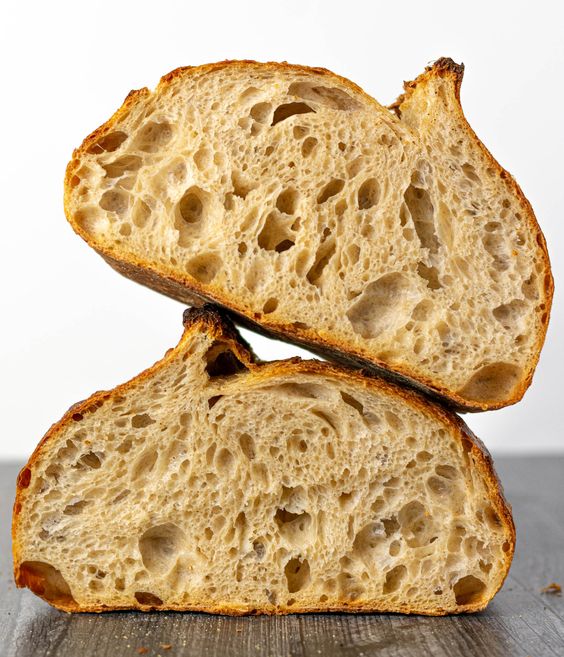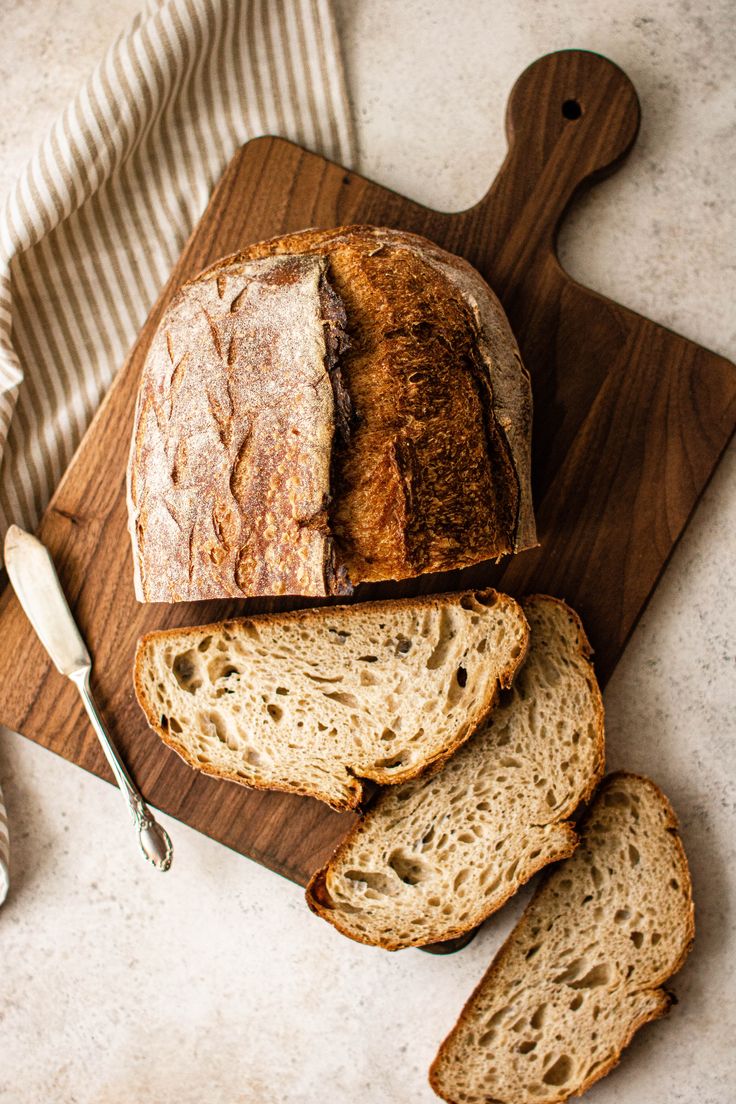Think homemade sourdough bread is out of reach? Think again! Sourdough Bread: A Beginner’s Guide is your ultimate recipe resource for easy, no-knead sourdough with simple, step-by-step instructions. Start the dough in the morning or evening—it only takes about 10 minutes to prepare. The result? A beautifully light, crisp, and tangy loaf!

WHAT IS SOURDOUGH BREAD?
Sourdough bread is a slow-fermented bread that rises without commercial yeast. Instead, it relies on a live culture known as a sourdough starter, which acts as a natural leavening agent. Sourdough is celebrated for its tangy flavor, chewy texture, and crisp crust. Health-wise, it’s a standout compared to store-bought bread, as the natural acids and long fermentation process break down gluten, making it easier to digest and more nutrient-rich. Plus, it’s delicious!
INGREDIENTS
- 150g (5.35 oz) bubbly, active sourdough starter
- 250g (8.80 oz) warm water (preferably filtered)
- 25g (0.90 oz) olive oil
- 500g (17.65 oz) bread flour (not all-purpose)
- 10g (0.4 oz) fine sea salt
- Fine ground cornmeal or parchment paper for the Dutch oven
NOTES & TIPS
- Weigh Ingredients: For best results, use a digital scale to weigh your ingredients. This ensures accurate flour-to-water ratios.
- Adjust Water for Texture: You can increase the water to 300g-325g for a softer, more pliable dough. If you do this, use a cloth-lined bowl for the second rise instead of a Dutch oven.
- Dutch Oven Size: A 5.5 or 6 quart Dutch oven is needed for baking.
- Flour Brands: This recipe works well with King Arthur, Gold Medal, and Pillsbury bread flours.
INSTRUCTIONS
MAKE THE DOUGH
- In a large bowl, combine the sourdough starter, warm water, and olive oil. Mix with a fork until combined.
- Add the bread flour and salt. Continue mixing with the fork until the dough becomes stiff.
- Use your hands to squish everything together, incorporating all of the flour. The dough will be dry and shaggy.
- Cover the bowl with plastic wrap, reusable wrap, or a clean, damp kitchen towel. Let it rest (autolyse) for 30 minutes to 1 hour.
BULK RISE
- After resting, work the dough into a rough ball for about 15 seconds.
- Cover the bowl with oiled wrap or transfer the dough to a high-sided tub with a lid. Let it rise in a warm spot (ideally 70-75°F/24-26°C) until it has nearly doubled in size. This can take 3-12 hours depending on temperature and starter potency.
OPTIONAL STRETCH & FOLD
- 30-45 minutes into the bulk rise, stretch and fold the dough to strengthen it. Gather a portion, stretch it upwards, and fold it over itself. Rotate the bowl and repeat until you’ve done this all around. You can do this once or twice spaced about an hour apart.
CUT & SHAPE THE DOUGH
- Lightly flour one half of your work surface and leave the other half clean.
- Remove the dough from the bowl and place it on the floured side. No need to punch down the dough; it will gently deflate as you shape it.
- Cut the dough in half for two loaves or leave it whole for one.
- To shape, move the dough to the clean side, fold it towards the center, give it a slight turn, and repeat until you complete a circle.
- Flip the dough seam side down and gently rotate it, using quarter turns to create surface tension. Repeat until satisfied with the shape.
SECOND RISE
- Coat the bottom of your Dutch oven with cornmeal or line with parchment paper.
- Place the shaped dough inside for a 30 minutes to 1 hour “free form” second rise, covered with the pot lid. The dough should be slightly puffy but not doubled in size.
- Preheat your oven to 450°F/232°C towards the end of this rise.
Note: For wetter doughs (300-325g water), skip the free form rise in the Dutch oven and use a floured proofing basket instead.
SCORE THE DOUGH
- Just before baking, make a shallow slash (2-3 inches) in the center of the dough with a bread lame, razor blade, or sharp knife, about 1/4-inch deep.
BAKE THE DOUGH
- Place the Dutch oven in the oven (lid on) and reduce the temperature to 400°F/204°C. Bake for 20 minutes.
- Remove the lid and bake uncovered for another 40 minutes until deep golden brown.
- For accuracy, check the internal temperature; it should be 205-210°F/96-98°C.
- Remove from the oven and cool on a wire rack for at least an hour before slicing to avoid a gummy texture.
Enjoy your homemade sourdough!







